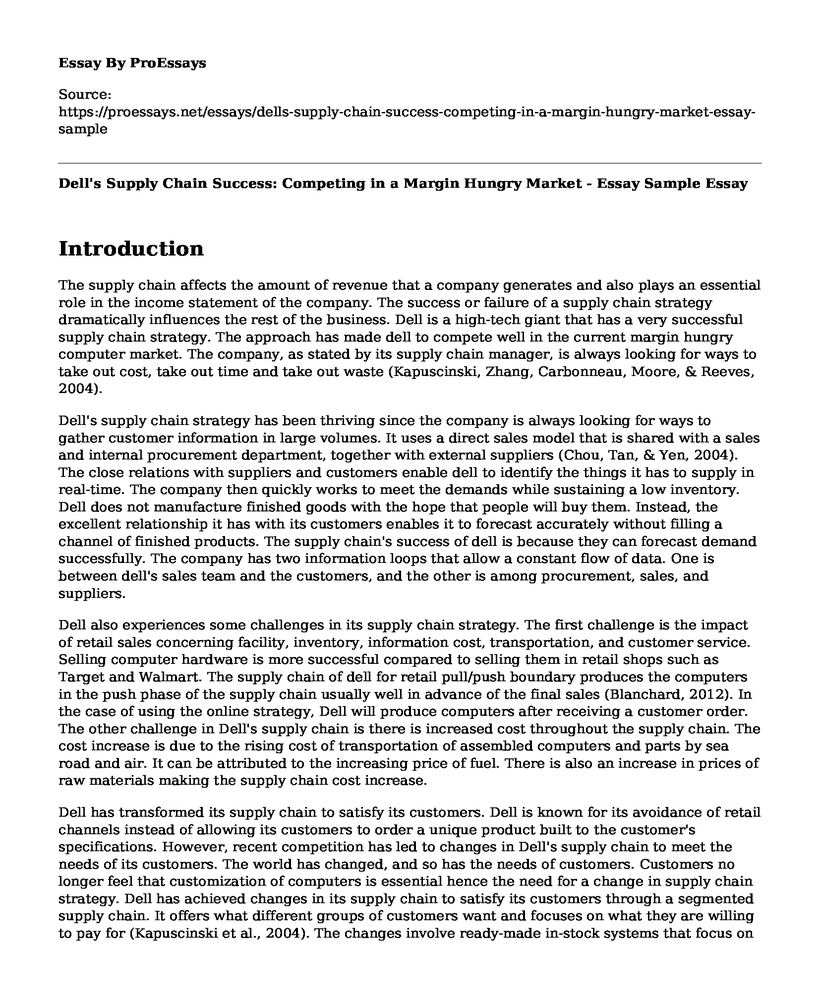Introduction
The supply chain affects the amount of revenue that a company generates and also plays an essential role in the income statement of the company. The success or failure of a supply chain strategy dramatically influences the rest of the business. Dell is a high-tech giant that has a very successful supply chain strategy. The approach has made dell to compete well in the current margin hungry computer market. The company, as stated by its supply chain manager, is always looking for ways to take out cost, take out time and take out waste (Kapuscinski, Zhang, Carbonneau, Moore, & Reeves, 2004).
Dell's supply chain strategy has been thriving since the company is always looking for ways to gather customer information in large volumes. It uses a direct sales model that is shared with a sales and internal procurement department, together with external suppliers (Chou, Tan, & Yen, 2004). The close relations with suppliers and customers enable dell to identify the things it has to supply in real-time. The company then quickly works to meet the demands while sustaining a low inventory. Dell does not manufacture finished goods with the hope that people will buy them. Instead, the excellent relationship it has with its customers enables it to forecast accurately without filling a channel of finished products. The supply chain's success of dell is because they can forecast demand successfully. The company has two information loops that allow a constant flow of data. One is between dell's sales team and the customers, and the other is among procurement, sales, and suppliers.
Dell also experiences some challenges in its supply chain strategy. The first challenge is the impact of retail sales concerning facility, inventory, information cost, transportation, and customer service. Selling computer hardware is more successful compared to selling them in retail shops such as Target and Walmart. The supply chain of dell for retail pull/push boundary produces the computers in the push phase of the supply chain usually well in advance of the final sales (Blanchard, 2012). In the case of using the online strategy, Dell will produce computers after receiving a customer order. The other challenge in Dell's supply chain is there is increased cost throughout the supply chain. The cost increase is due to the rising cost of transportation of assembled computers and parts by sea road and air. It can be attributed to the increasing price of fuel. There is also an increase in prices of raw materials making the supply chain cost increase.
Dell has transformed its supply chain to satisfy its customers. Dell is known for its avoidance of retail channels instead of allowing its customers to order a unique product built to the customer's specifications. However, recent competition has led to changes in Dell's supply chain to meet the needs of its customers. The world has changed, and so has the needs of customers. Customers no longer feel that customization of computers is essential hence the need for a change in supply chain strategy. Dell has achieved changes in its supply chain to satisfy its customers through a segmented supply chain. It offers what different groups of customers want and focuses on what they are willing to pay for (Kapuscinski et al., 2004). The changes involve ready-made in-stock systems that focus on quick delivery. Another difference is that Dell offers customizable configurations in its computers. Dell has also introduced standardized offerings for the most bought settings.
Conclusion
Supply chain strategy is an essential aspect for a company to succeed in doing business. Dell is a computer company that has been successful in its supply chain strategy. This success can be attributed to the company's dedication to gathering information on what customers want. Dell has also faced some challenges in its supply chain strategy that have led to the need for changes. The change in the supply chain strategy has enabled Dell to satisfy its customers.
References
Blanchard, D. (2012). SUPPLY CHAIN & LOGISTICS: Dell Taps into Innovation to Reach Emerging Markets. Industry Week-Cleveland, 261(11), 45.
Chou, D. C., Tan, X., & Yen, D. C. (2004). Web technology and supply chain management. Information management & computer security, 12(4), 338-349.
Kapuscinski, R., Zhang, R. Q., Carbonneau, P., Moore, R., & Reeves, B. (2004). Inventory decisions in Dell's supply chain. Interfaces, 34(3), 191-205.
Cite this page
Dell's Supply Chain Success: Competing in a Margin Hungry Market - Essay Sample. (2023, Feb 25). Retrieved from https://proessays.net/essays/dells-supply-chain-success-competing-in-a-margin-hungry-market-essay-sample
If you are the original author of this essay and no longer wish to have it published on the ProEssays website, please click below to request its removal:
- Course Work on Marketing: Relationship Between Brand Image and Consumers' Purchase Intentions
- The Principle of Public Relations and Public Affairs Essay
- AirAsia Assets Case Study Paper Example
- Importance of Archives in an Organization Paper Example
- Genki Sushi Shop Globalization Paper Example
- Essay Sample on Stock Market Analysis
- Walmart: Global Leader in Low Prices, Looking to Grow Reputation - Essay Sample







